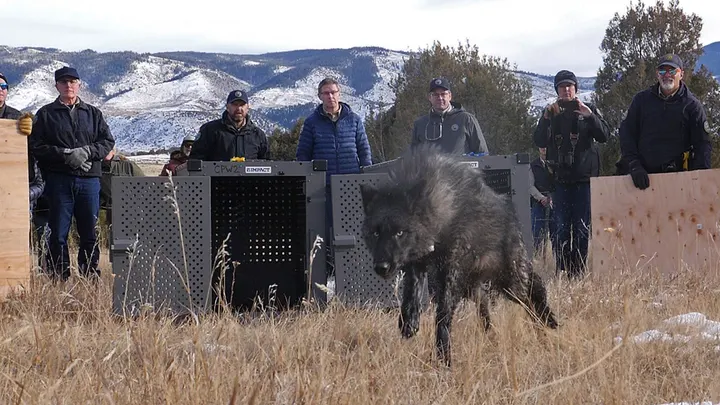Monday, December 18th, 2023, marks the historic and controversial reintroduction of gray wolves into Colorado’s wilderness. Officials from the Colorado Parks and Wildlife Service (CPW) spent the previous day capturing five wolves in Oregon and transporting them to an undisclosed release site on Colorado’s Western Slope. The relocation of these wolves satisfies the December 31st deadline for gray wolf reintroduction in Colorado, as mandated by Proposition 114 — a bill that state voters narrowly approved in February 2020. The release follows a last-minute lawsuit filed by the Colorado Cattleman’s Association, which was unsuccessful in its attempt to delay the reintroduction process.
The five wolves, two pairs of 1-year-old male and female siblings and a 2-year-old male, were captured from areas of Oregon where their removal will not affect the state’s conservation goals, according to Oregon Fish and Wildlife Director Curt Melcher. After undergoing a thorough health check by veterinarians and receiving vaccinations, CPW fitted the wolves with GPS collars which will transmit their location at least once daily, allowing the agency to monitor their movements and locate them as needed.
Gray wolves, once native inhabitants of Colorado’s forests and mountains, were effectively exterminated from the state by the 1940s. Their status as an endangered species, recognized by both the state of Colorado and the federal government, is a key driver behind this reintroduction initiative.
“This is a moment of rewilding, of doing something to stave off the biodiversity extinction crisis we are living in,” says Joanna Lambert, professor of wildlife ecology and conservation biology at the University of Colorado at Boulder, who witnessed the release.
The CPW cautions that it’s difficult to use other states’ experiences to anticipate the impact of wolf reintroduction in Colorado. They state that reintroduction “will create a unique opportunity for a wealth of research on how wolves may navigate more populated areas, how the species adapts to the effects of a changing climate and potential roles in disease control or ecological impacts on the Colorado landscape.”
Opponents of reintroduction, comprising 49.1% of Colorado’s voters who rejected Proposition 114, express concerns about the impact of wolves on rural communities. They argue that wolves pose a threat to livestock and pets and could diminish elk and other big game populations vital to the state’s hunting tourism.
The Colorado Cattlemen’s Association (CCA), a livestock organization with a history predating Colorado’s statehood, manages or leases about 25 million acres, constituting 70% of the state’s grazing land. At the forefront of wolf reintroduction opposition, the CCA recently filed a lawsuit against the U.S. Fish and Wildlife Service (FWS) and CPW, seeking to postpone the initiative. Last Friday, a judge dismissed the lawsuit against wolf reintroduction, stating that the ‘possible impacts’ did not warrant postponing the voter-approved plan.
In the event of a livestock death due to a wolf attack, ranchers will receive compensation of $15,000 per animal killed, an amount considered fair market value. Additionally, after the U.S. Fish and Wildlife Service (USFWS) classified Colorado’s wolves under section 10(j) of the Endangered Species Act this September, ranchers are now permitted to lethally remove any wolves caught attacking their livestock.
In the coming 3 to 5 years, the CPW plans to release between 10 and 15 wolves each year, aiming for a total of 30 to 50 wolves. After this period, the focus will shift solely to monitoring the wolves’ population sustainability.
The CPW cautions residents of Colorado and neighboring states to expect the wolves to disperse widely, potentially reaching more populated Front Range areas. As the process of wolf reintroduction progresses, there is a growing concern about the potential increase in livestock attacks and subsequent retaliatory killings.
Diane Boyd, a wildlife biologist with over 40 years of experience in wolf conservation, stated to the Coloradoan, “Wolves don’t unlearn this habit,” regarding livestock depredation. Boyd, considered the ‘Jane Goodall of Wolves,’ was commissioned by the National Wildlife Federation to write a report reviewing scientific findings from gray wolf reintroduction in other states to inform Colorado’s reintroduction process. “Colorado is going to have to accept the fact that some wolves will need to be removed,” says Boyd.
The release of these first 5 wolves represents a significant step toward the CPW’s goal to “recover and maintain a viable, self-sustaining wolf population in Colorado.” Even so, this is only the beginning of a complex process that will strive to balance the native right of wolves to roam free in Colorado with the well-being of its citizens.
2023-12-17 | Oregon Wolf Captures from Colorado Parks & Wildlife on Vimeo.
Colorado Wolf Release 12-18-23 from Colorado Parks & Wildlife on Vimeo.

